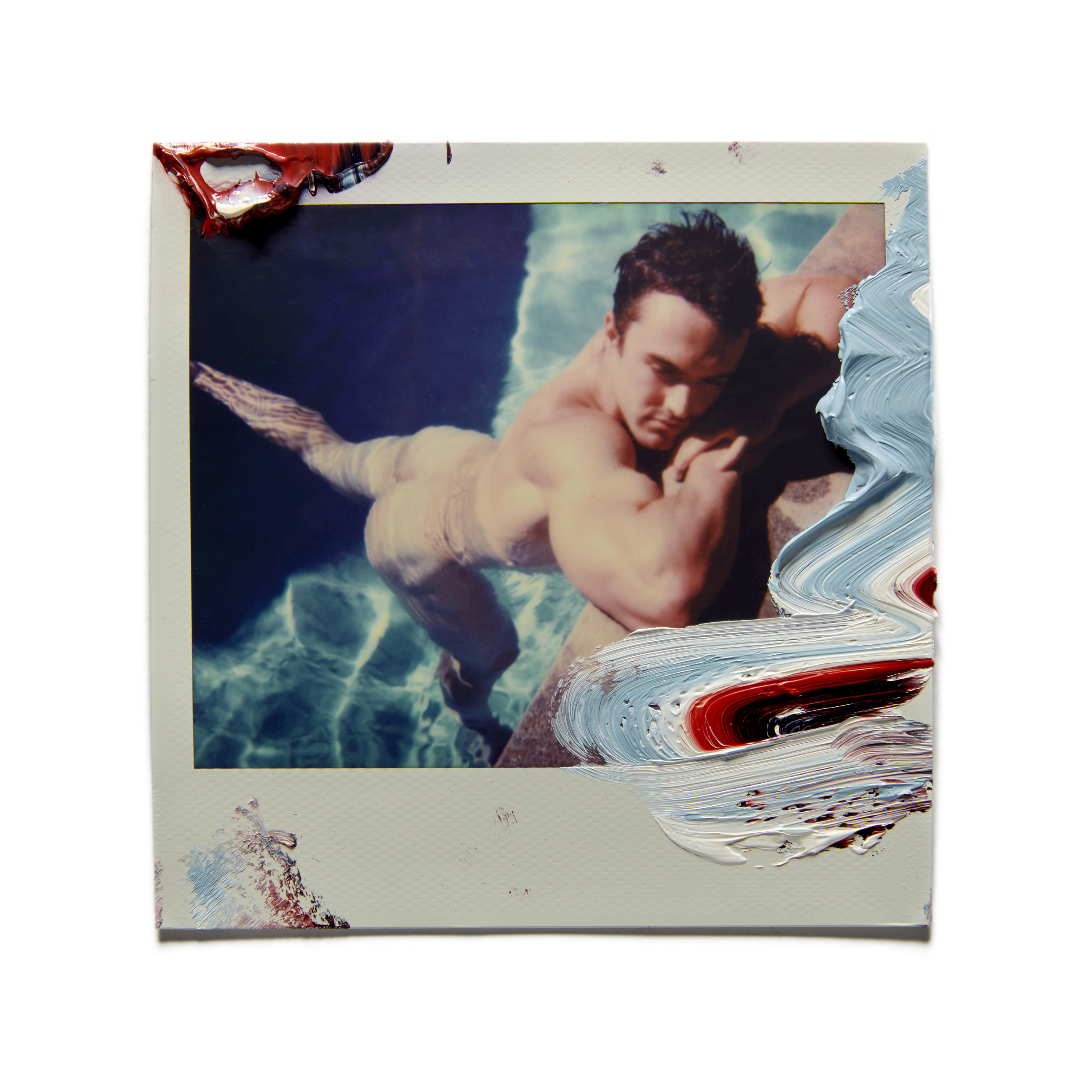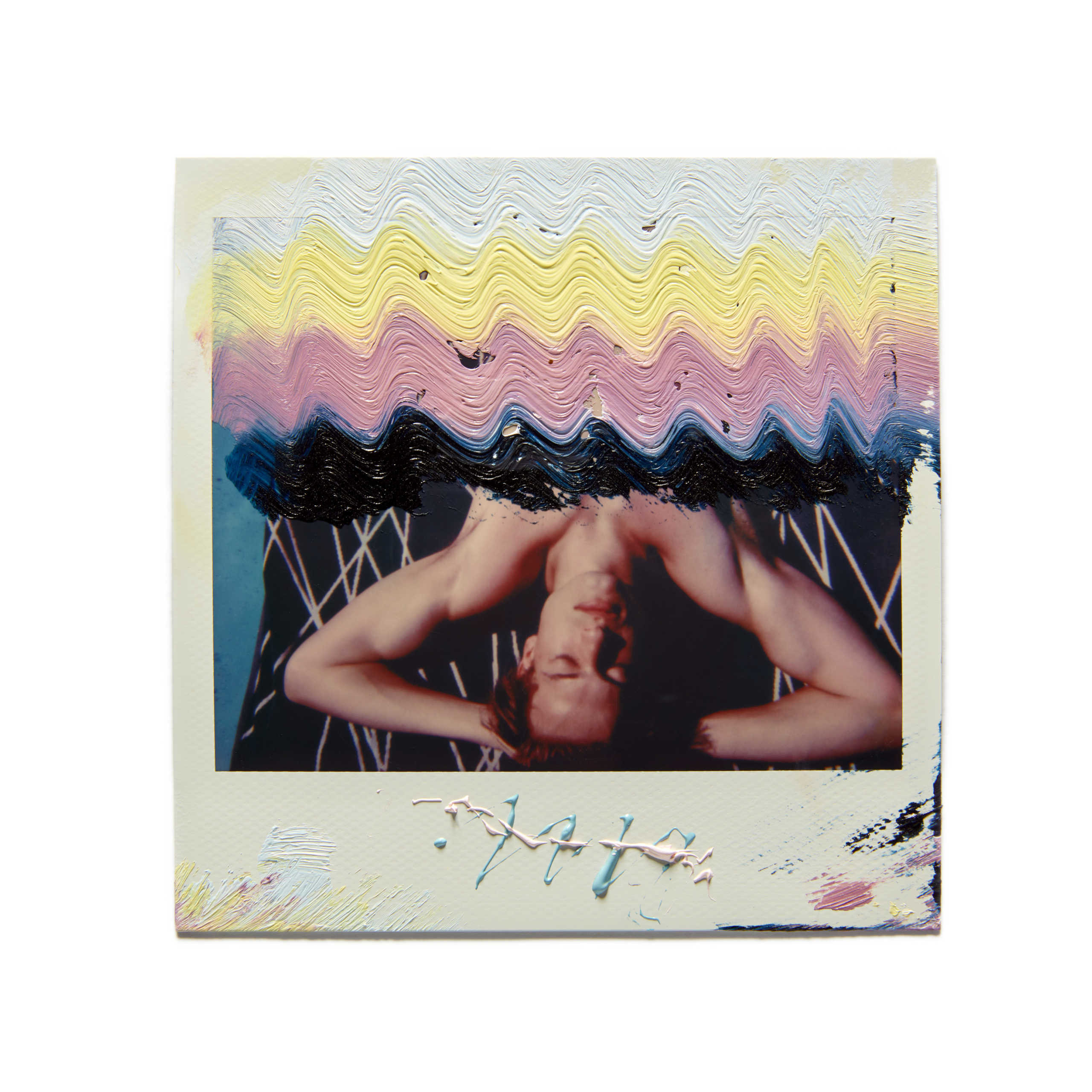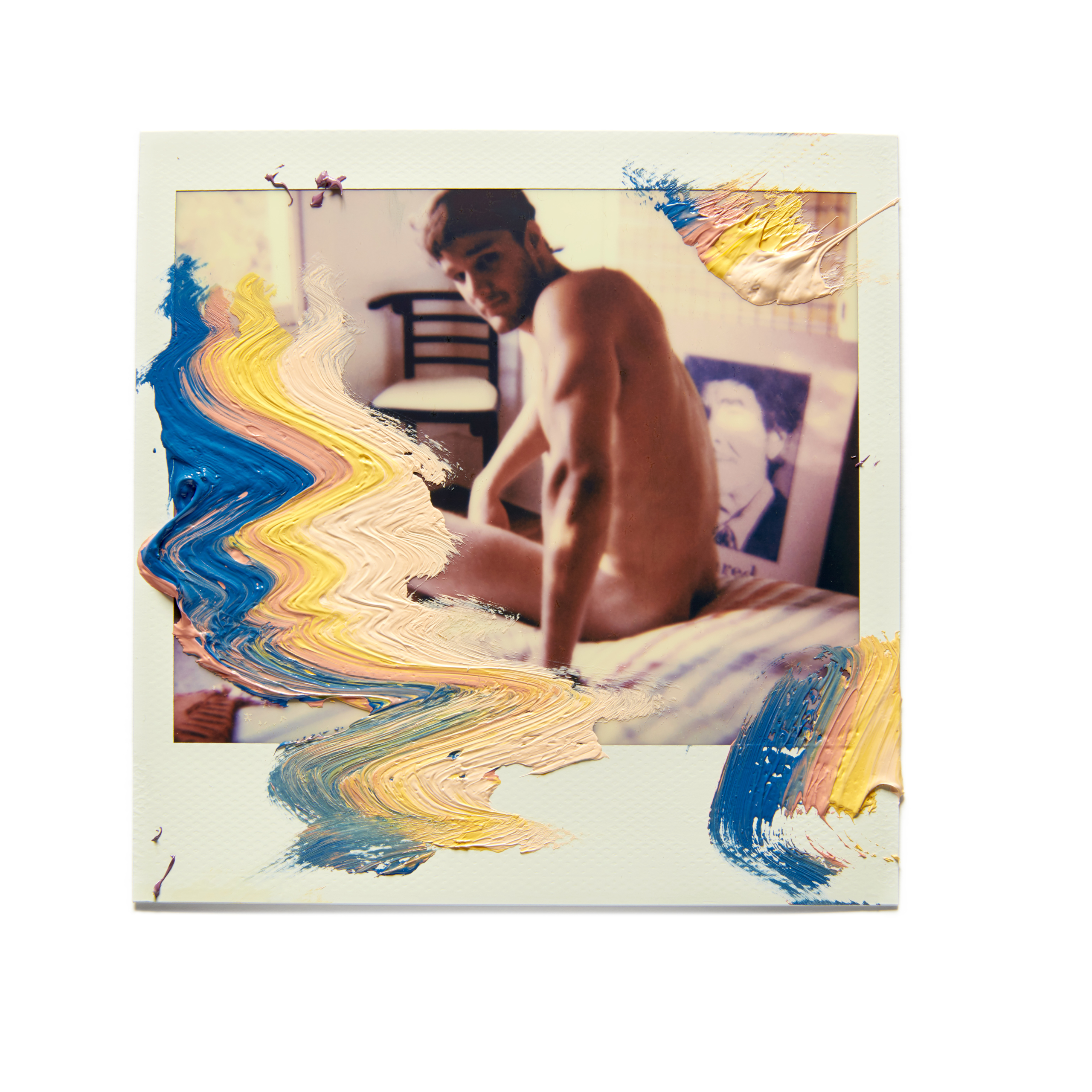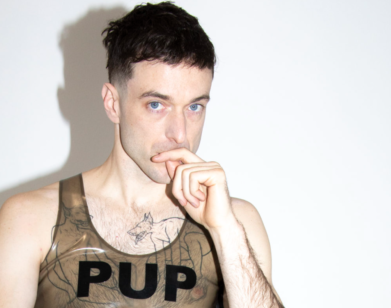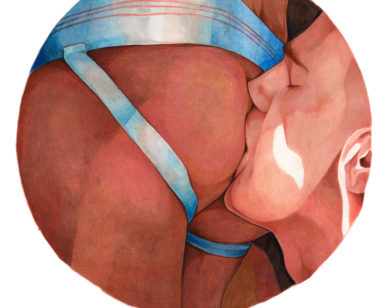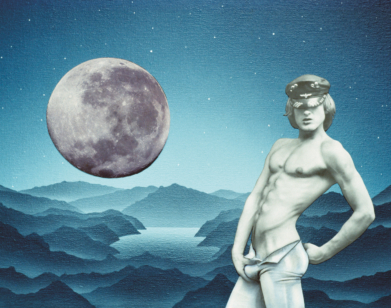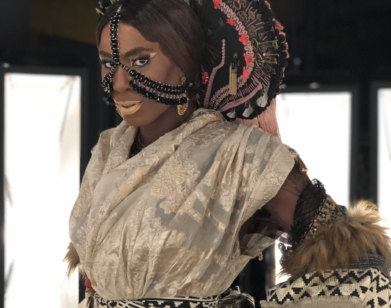The Pretty Boys of Jeremy Kost
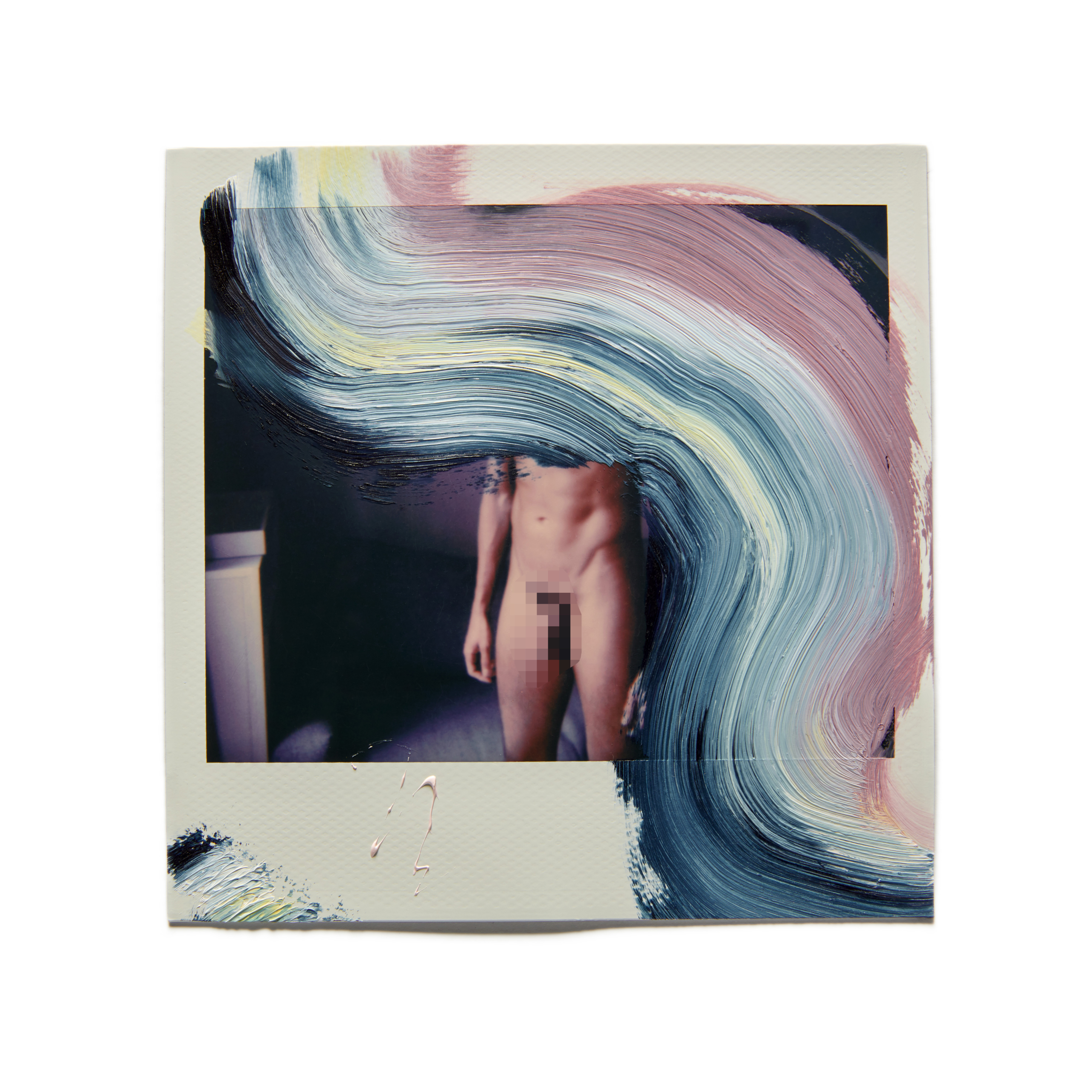
Adonis. Antinous. Hercules. Diplo. Physical idealism has worn many faces throughout history, and yet the guise of masculinity has endured since the dawn of time. Sculpted pecs, barreled chests, and abs of steel have long represented a manifestation of what it means to be a beautiful man, and image-makers of all stripes have long chronicled the brawny male archetype in their craft. Cinemas have seen Tom Cruise shimmy across living rooms in his skivvies; marbled macho men cast shadows across city streets in Rome; and with his latest exhibition, the contemporary artist John Currin offers a zany, introspective look at manhood.
Jeremy Kost is another artist whose current work tackles the male form, but also answers the question of what it means to portray the muscled man in the digital age. For one, it comes with repercussions. As Kost explains, his latest show and self-published book, Seismic Dreams, is a direct reaction to a near year-long Instagram shadow ban that has impeded his impact on the social media site. Despite abiding by community guidelines, past hiccups with censorship rules have halted Kost’s engagement on his profile, which serves a following of nearly 600,000. Per the guidelines, the site encourages nudity in painting and sculptures, but sends scantily-clad thirst traps into oblivion—even if they are being uploaded by an artist like Kost.
Taking his snapshots literally off the grid, Kost brought Seismic Dreams to Circus of Books, the LA-based bookstore-slash-sex shop that will soon be the subject of a Netflix documentary. The store, which recently reopened to feature a dedicated gallery space, showcases Kost’s polaroids—a body of work that reverberates like a record player reeling a vinyl of “Sex with Me” by Rihanna on repeat. Cool waters and earthy backdrops offer a sumptuous setting for manly boys to frolic in the wind in candy-colored Speedos. Oil paints drip like sherbet across the photographs, melting and swirling. After speaking with Kost about the exhibit, I conclude the photos are perhaps best seen offline. After all, as Rihanna wisely says, “stay up off my Instagram, pure temptation.”
———
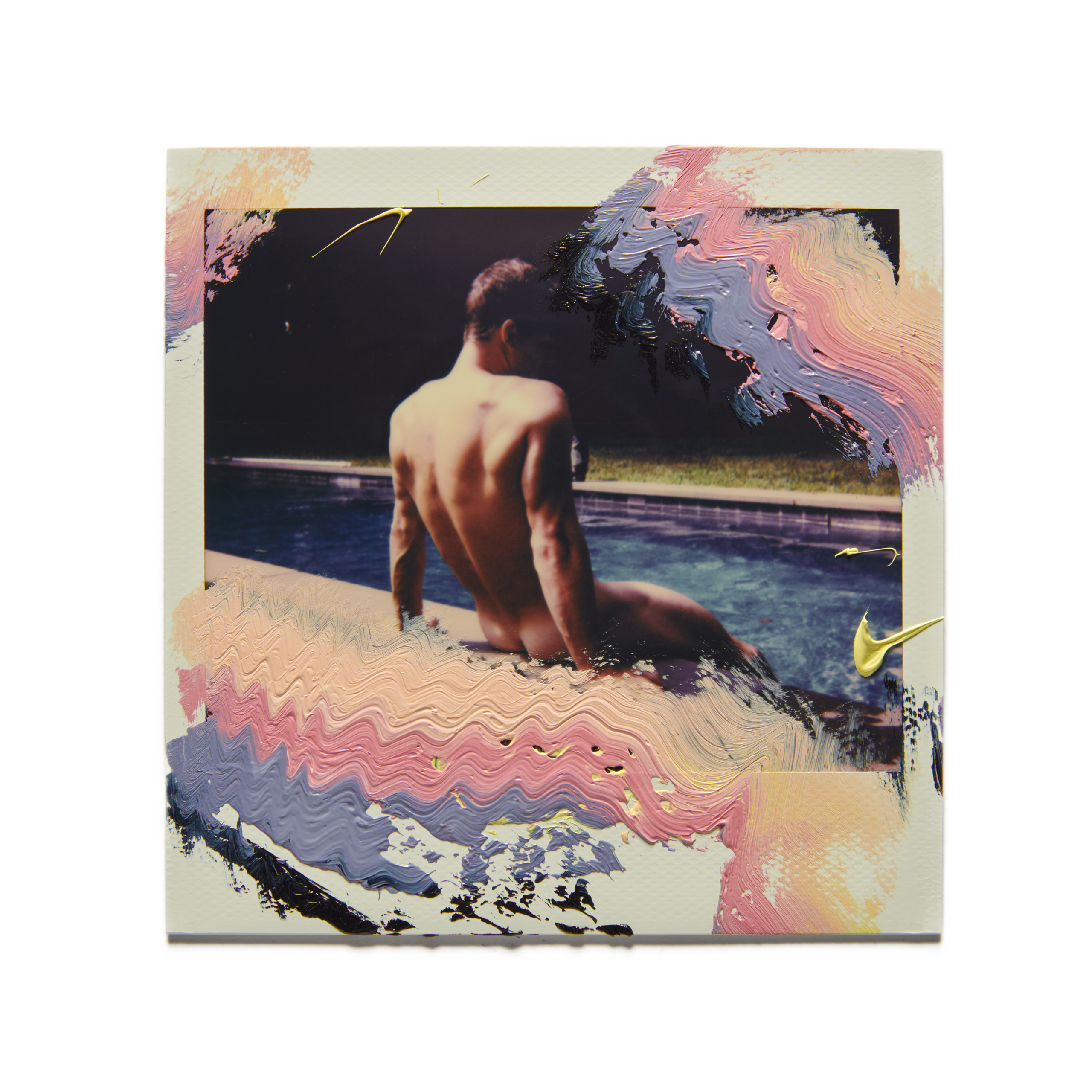
MITCHELL NUGENT: Although you consider yourself bicoastal, I’m wondering if there are ways in which you’ve seen the landscape of queer venues and perhaps gay culture at large shift specifically in Los Angeles over the past decade?
JEREMY KOST: I get the impression that L.A. is going through an amazing moment of different queer parties sort of flexing their muscles and doing really interesting things outside of the traditional West Hollywood sort of mold, and creating spaces for people, which reminds me of what New York was when I first moved there in 2004. I think that as I’ve gotten older, maybe I try not to think of myself as jaded, but maybe I’m a bit jaded. When I’m in New York, I try to be the person who is the old New York queen who’s going, “It’s not what it was and it’s not as cool as it was and whatever.”
NUGENT: The advent of Amazon and digital publishing has disrupted the brick and mortar bookselling business, and gay book stores haven’t been immune to this. What does a queer institution like Circus of Books mean to you?
KOST: Well, I think that’s what caused it to close. People weren’t buying books or pornography in the same way that they used to. Fortunately, Rob Novinger, who owns Chi Chi LaRue and owns a sex toy company, saw value in the history of Circus of Books and thought it was worth reinvesting in and reopening the store. When you think about what it represents as a sort of landmark for Los Angeles—but as a landmark as a safe space, as a place of sort of gathering. The documentary that Rachel Mason is releasing on Netflix [about her parents this April] paints a pretty powerful picture of the couple…and the way that the store became this sort of gathering place for people. The way she’s looking at buying dildos is sort of no different than buying erasers for a school supply store. It’s an interesting sort of portrait of a place, but I think that that legacy is kind of really special.
NUGENT: That’s beautiful. With the return of Circus of Books, the space will feature a dedicated gallery space for LGBTQIA+ artists and their work, starting with yours. How does it feel to have your show to be included in the new iteration?
KOST: It’s exciting. I think the idea of being able to do a show in a space that has so much history is equal parts odd and exciting. There’s something about being an artist who has worked for a long time and had exhibitions, and everything from a pop-up space…to being in a Warhol Museum solo show. To then be doing an exhibition where there’s a U of white walls, and on the other side…there’s dildos, poppers, and lubes. There’s something kind of odd about it, but also sort of great. I think that you have to kind of embrace that oddness. There’s all these stories of Elton John having gone in and buying tons of pornography all the time. To be able to exercise the history of a physical space with one’s work in a different time and place is pretty awesome.
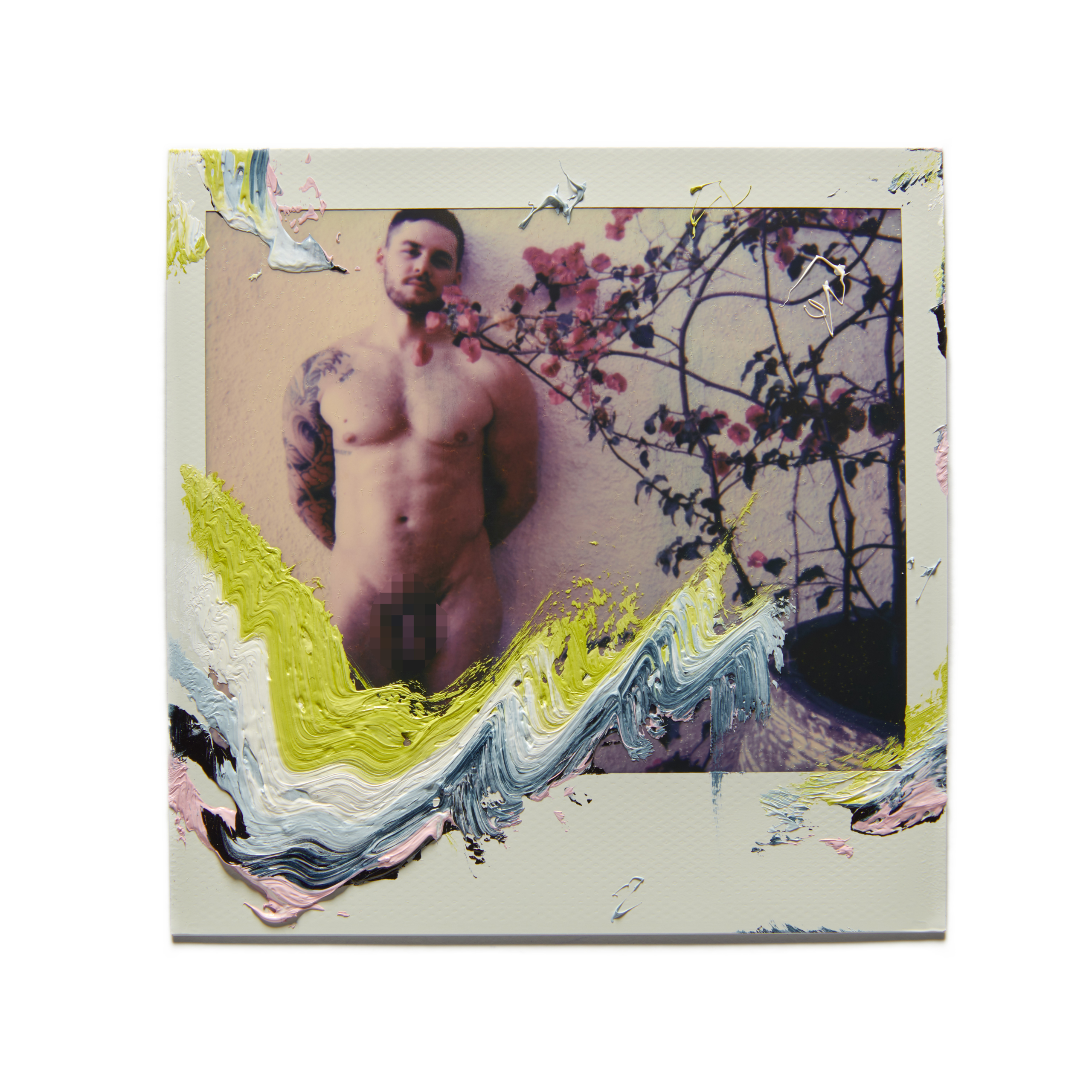
NUGENT: Absolutely. The work in Seismic Dreams reminds me of this Greek word “phantasia” that describes the relation between perception and judgment, and imagery that conjures viewers to enter this dream-like state. For me, the juxtaposition of the male form with the blend of pretty oils and the haziness of Polaroid film conjures this dreamy fantasy. How did the collection of work come together?
KOST: Well, I released a book a year ago called Isolated But Not Alone. With all the books that I’ve done, there’s a really interesting connection to Interview. My book designer and Creative Director for all the books that I’ve done is Sam Shahid, who was the Creative Director of Interview under Ingrid Sischy. Isolated But Not Alone were these heavy sort of super built up marks made mostly through gestures and mark-making. The Seismic Dreams ones to me felt a bit more painterly and a bit more intentional, a bit more considered. They kind of came together pretty organically as an extension of where I left off in the last book. But part of it, to be perfectly frank, was a bit of a reflex towards Instagram having me in this shadow ban situation for 10 months now.
NUGENT: That’s so fascinating.
KOST: Part of the reason I released the book was a reflex of going, “You know what? I was an artist before Instagram, and I’m going to be an artist without Instagram. I’m making this book because I feel the need to make it, not because I’m caught up in followers and likes and whatever.” So, [the show] is kind of a hybrid of a couple of different things. One was a reclamation of my mental space as an artist. It was really like, “I’m tired of playing the victim and letting Instagram dictate my emotional state and mental state. I’m going to reclaim that with a book that I want to make because I feel the need to make it.”
NUGENT: I was actually going to ask you about Instagram because you’ve built this massive following and this quasi-gallery for audiences to become introduced to your art and follow your work. In this digital age, why do physical gallery shows still matter?
KOST: I think there’s a fundamental different experience that happens when you look at an object in person. I think that you have a different experience with the way the paint reflects light, or the way the Polaroid looks in the frame as a sort of jewel in a shadowbox frame. The way that you flip pages in a book or a magazine is a fundamentally different experience than clicking an image that you double-tap and you maybe never look at again. I think that the experience one has with a book or an object is such a rich experience relative to where we are with digital consumption.
The collective narrative of me and Polaroid with oil paint sort of talks about different ideas. There’s this notion of fetish. The fetish of boy, the fetish of Polaroid, the fetish of paint. 9 out of 10 times, everything that we’re consuming now digitally is this high-color, high-contrast, sort of punchy image. Here, the high-color, high-contrast, high-punch thing is the paint, whereas what would generally be looked at as sort of the object of desire, the boy, is sort of muted and softer, and a bit more grainy because of the Polaroid. So, it becomes this reversal, reframing that conversation.
NUGENT: That’s wonderful. From a tactical standpoint, the Polaroid seems to me to be so fickle. There’s no perfect Polaroid, but I’m wondering when you know it’s the right one? Do you get a certain feeling?
KOST: They’re hard. I’ve been doing Polaroids since 2000. So, at this point, it’s almost fucking 20 years.
NUGENT: [Laughs] Right.
KOST: I kind of know what I’m doing by now. I don’t use any lighting, it’s all-natural lighting only. I know the limitations of the medium and I have a pretty good sense of what I’m going to get before I shoot it. But I’ve always had this constraint that I don’t look at the work when I’m making it. I make them and the new film has to develop in a dark bag to develop optimally. Even when I was shooting in nightlife and publicly, I never looked at the images until a few hours later. I always tried to look at it as capturing a moment as I saw it and not trying to recreate something that I saw. I think that there’s sort of this push and pull of seeing something, trying to capture it the way that your eye is seeing it, and then coming back to it later, and then editing what you’ve made. But with the Polaroid, it’s kind of like you get one shot to get it right.
NUGENT: I’m personally obsessed with Polaroids, particularly Andy Warhol’s. Do you have any particular favorite Polaroids of Andy’s?
KOST: There are so many. In 2012, I was very fortunate to have been able to do a show with the Warhol Museum in New York where I was able to choose 21 of Andy’s Polaroids to pair with my work. It was a pretty awesome opportunity to be able to choose a handful of them that spoke to me. I love Andy’s male nudes. Warhol once famously told Bob Colacello—as Bob was having a hard time selling them, which I can so relate to—”Bob, tell people that they’re landscapes.” I still love that idea. The reality is, the contemporary art world is not exactly super embracing of male nudity. It is what it is.
NUGENT: When did you first pick up a Polaroid camera?
KOST: In 2000 or 2001, something like that. I hit on this guy in Philadelphia when I lived in Washington, D.C., and he and his boyfriend [Pedro] would become my super close friends in New York. I would visit them once a month for like 2 and a half years. Pedro was a coat check and bartender at The Cock and these places in the East Village. Pedro had a Polaroid camera on the wall of his apartment and I had come from running the largest nightclub with two other partners in Washington, D.C., with like 2,500 queens on a Saturday night. But it was D.C., so they were all wearing Abercrombie polo shirts, jeans and khaki shorts, and whatever. To then go to The Cock where you have a biological woman pulling eggs out of her pussy, cracking them and drinking the yolks was a bit of a shock. So, I took Pedro’s Polaroid camera to The Cock one night, and the rest is sort of history.
NUGENT: Wow, that’s amazing!
KOST: I feel like my whole career and my whole life has sort of been this bizarre organic thing of seeing where something is going, seeing how I react to it, making adjustments, and sort of moving in that direction. It could be a lot worse.
NUGENT: For me, your work invokes this kind of gay bucolic, luscious world that transports me back to another time. There’s so much romanticism that I find in your photographs. For me, it outshines the frank eroticism. Is there a particular way you describe your work of the male form?
KOST: Well, I think there’s a couple things that I think get lost in what I’ve done. I think that most people don’t realize that the work is about a lot of different things. But one of them is my sort of body identity. Having [once] been 250 pounds and sort of closeted until I was 22 [years old], and [my work] is sort of this manifestation of perfection and sort of this idealized perfection. So, that form sort of manifests through these guys. I think the nature of the Polaroid and even my digital images on Instagram–being all iPhone images–there’s an inherent intimacy that comes with them.
I don’t really think about them as erotic so much. I try not to at least, because it’s not really about gay or straight. It’s just sort of this idealized form and this sort of narrative of perceived perfection. I try to continue to explore the sort of intimate moments with people, but try to just let them be honest. The biggest thing is just let them be honest. Let the images be really what they are and not try to force them to be something else.
NUGENT: For me personally, I think around 9 or 10 years old, I first discovered Abercrombie & Fitch ads, which to this day, represent this major catalyst in my life. They were my first entree into the beauty of the male form, both in a sexual way as a young gay male myself, but also as a future admirer of the male form in art. I was wondering if there was any particular moment in your early life that sparked your own admiration with the male form?
KOST: Well, I mean, it’s interesting to think that Shahid was the creative director of Abercrombie for all those years and is now working on my books. Sam is the one who created [A&F] Quarterly for Abercrombie.
NUGENT: Wow, I didn’t know that!
KOST: Yeah. Sam has a really rich history with Abercrombie. So, to have someone like that sort of look at my work and sort of treat my work with his sort of, his art so to speak, is kind of a really interesting full circle. I don’t remember if there was an exact moment. I mean, I definitely remember growing up and seeing the old Calvin [Klein] ads that Sam did too. But I don’t know if there’s really a definitive moment, to be honest. There was a progressive sort of realization when I was in high school that this was who I was. Then there was a subsequent sort of denial of that same feeling. Growing up in Texas in 1995, it wasn’t exactly super encouraged to say the least. Which I think is part of the reflex of why I make what I make. It’s sort of this repressed anxiety about who I really was, and then now I can sort of embrace it unapologetically.
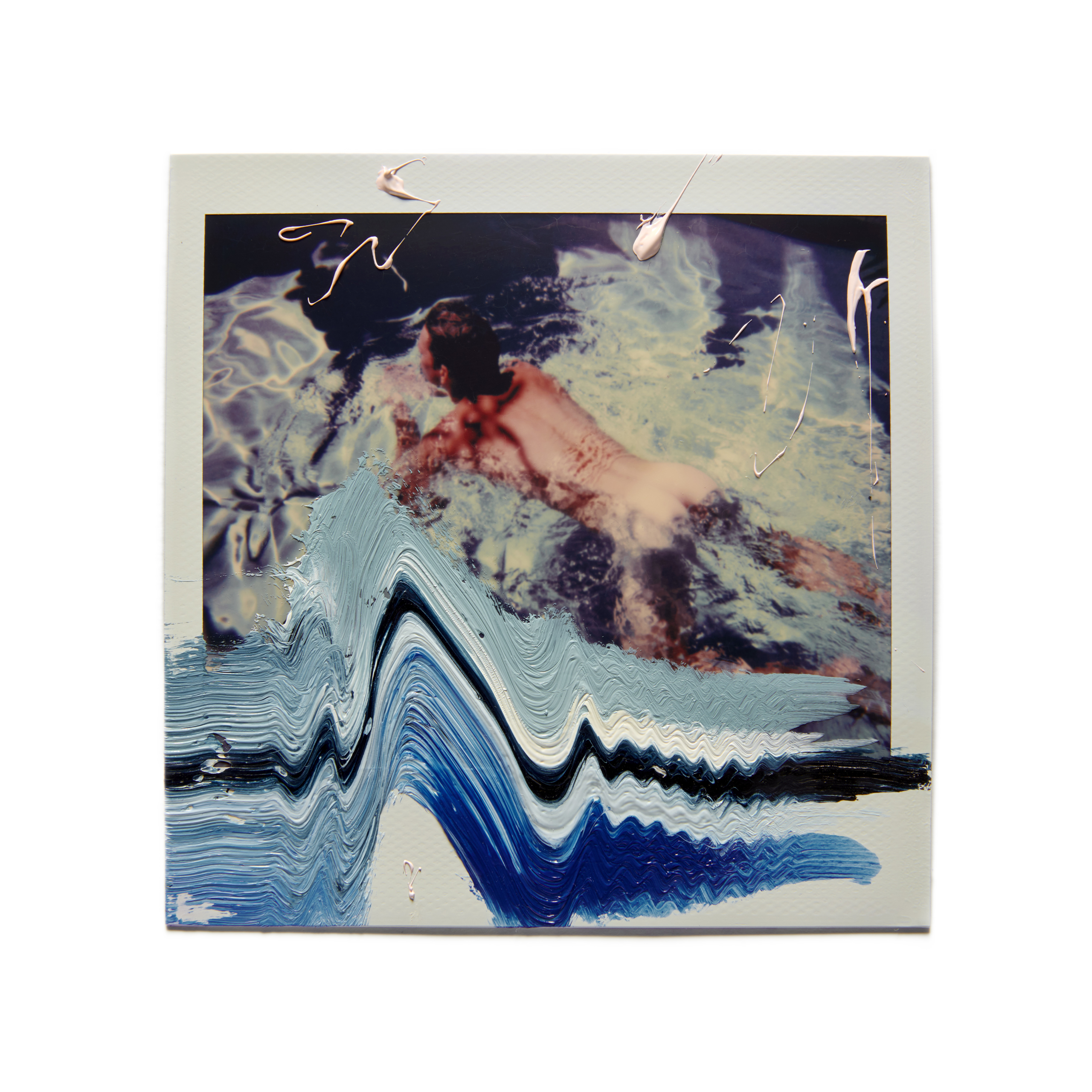
NUGENT: That’s incredible.
KOST: I think that the through line for all the guys that I shoot is that they were all people that I would be lusting after as a kid when I was closeted and in denial. So, it sort of brings it back to that place too.
NUGENT: I knew of Shahid, but I didn’t know that he worked for Abercrombie, so I’ve been influenced by his work unknowingly for so long. I’m personally obsessed with uncovering this male idealism and erotica in vintage advertising. My Instagram has become dedicated to it, and I find that it doesn’t really exist as much, or to the extent that it did in advertising throughout the ’70s, ’80s, and ’90s. I feel like everything is so censored now.
KOST: Yeah, it’s kind of crazy that we’re in this almost Puritanical sort of moment collectively, where everything is supposed to be about freedom of expression and authentic expression and whatever, but I find that things are being censored to an Nth degree. I’m not sure where it’s coming from, to be perfectly honest.
NUGENT: Yeah, it’s quite jarring. I don’t know who these Instagram police are.
KOST: I don’t know either.

